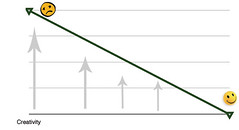
The most creative solutions to difficult problems often seem to come out of nowhere.
The mysterious nature of the “sudden flash of insight” has given rise to the myth of inspiration – the idea that brilliant ideas are visited upon us by some mysterious force or deity. That if your muse is being fickle today, all you can do is sit around and wait.
In fact, as Jonah Lehrer explains in his new book Imagine: How Creativity Works, neuroscientists are beginning to understand those flashes of creative genius that give rise to inventions like the Swiffer, or Bob Dylan’s groundbreaking tune Like a Rolling Stone. Numerous studies (such as Mark Beeman’s experiments with his unfortunately named CRAP, or Compound Remote Association Problems), are honing in on inspiration as a function of the right hemisphere of the brain – the less literal half that exceeds at making associations between things that don’t obviously go together.
It turns out that sitting around waiting is definitively the wrong way to trigger right-brain creative activity. What gets the alpha waves flowing, facilitating the semi-dream-state in which we’re best able to connect those unlikely dots, is a change of scenery – a long aimless walk, for example, or travel abroad. In this sense, the internet, an endless web of discovery and rabbit holes to alternate dimensions, is an enormous creativity machine.
The Outsider’s Insight – InnoCentive
What if we could harness the web’s unique power to enable unlikely insights?
via Big Think – Jason Gotsᔥ
Bookmark this page for “Creative Insight” and check back regularly as these articles update on a very frequent basis. The view is set to “news”. Try clicking on “video” and “2” for more articles.







